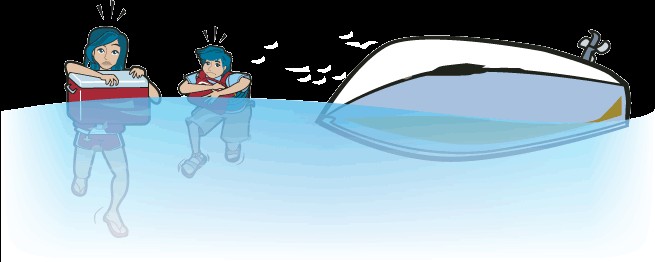Drowning is a leading cause of fatalities in small boating accidents, often following a fall overboard or capsizing. A significant statistic from the U.S. Coast Guard reveals that a staggering eighty-five percent of drowning victims in boating incidents were not wearing a lifejacket. Therefore, wearing a lifejacket at all times is paramount. But beyond this crucial safety measure, understanding the common causes of these incidents can significantly reduce the risk.
Let’s explore the factors that most frequently contribute to falls overboard and capsizing, enabling boaters to navigate waterways more safely.
Capsizing occurs when a boat overturns or is overwhelmed by water. Smaller vessels like canoes and sailboats are particularly susceptible. Fortunately, these types of boats typically remain buoyant even when capsized, offering individuals in the water a means of support.
Common causes of falls overboard and boat capsizing include being caught off guard by a sudden wave or sharp turn, overloading the boat or distributing weight unevenly, and navigating in adverse weather conditions.
Preventing Falls Overboard and Capsizing: Proactive Measures
Understanding the primary causes allows us to implement preventive strategies.
-
Maintain a Low Center of Gravity: Stay low and centered within the boat. When moving, ensure you maintain three points of contact for stability.
-
Control Speed and Angle: When navigating turns, reduce speed and approach the turn at a safe angle to prevent sudden shifts in balance.
-
Address Wakes Head-On: Be vigilant for wakes created by other boats, and when encountering them, approach head-on from the bow to minimize the impact and maintain stability.
If boating in unfavorable weather is unavoidable, reduce your speed to mitigate the risks posed by rough conditions.
 A boater slowly approaching a wave head-on from the bow of the boat
A boater slowly approaching a wave head-on from the bow of the boat
Finally, never secure the anchor rode line to the stern of the boat. This concentrates weight at the back, drastically increasing the likelihood of capsizing or swamping.
Responding to a Fall Overboard: Immediate Actions
If someone falls overboard from your boat, swift action is crucial:
Step 1: Immediately reduce speed and bring the boat to a stop.
Step 2: Quickly toss a buoyant object, such as a life buoy or lifejacket, to the person. This provides flotation and marks their location.
Step 3: Designate a person on board to continuously monitor the individual in the water, pointing to their location at all times.
Step 4: Carefully maneuver the boat to approach the person, positioning them on the operator’s side.
Step 5: Throw a buoyant heaving line or a life buoy attached to a line to the person in the water.
Step 6: Pull the person to the boat and assist them in re-boarding using the boat’s ladder. If a ladder is not available, a heavy rope or chain draped across the stern can serve as a temporary step.
In most cases, the person will re-enter the boat from the stern. To prevent further incidents, remember to turn off the engine before assisting them.
Survival Techniques: In the Event of Capsizing or Falling Overboard
If you find yourself in the water after a capsizing or fall overboard:
- Remain calm and conserve energy.
- If you were boating with others, conduct a headcount to ensure everyone is accounted for and stay together.
- If possible, re-board the boat.
- Stay with the boat unless it poses a hazard. Small boats generally float, and holding onto the boat helps conserve energy and increases visibility to potential rescuers.
- In a fast-moving river, float on your back with your feet pointing downstream.
- Prioritize exiting the water as quickly as possible.
Falls overboard and capsizing underscore the critical importance of wearing a lifejacket. A lifejacket can significantly improve your chances of survival by conserving energy, providing warmth, and keeping you afloat while awaiting rescue.